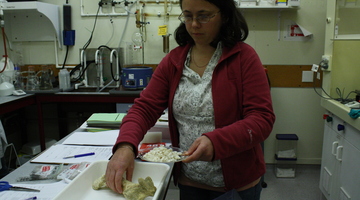Dr Fiona Petchey’s main research interest is in marine shell dating. Shell dating is one of the main ways of tracking the movement of people through the Pacific region, since shellfish formed part of the diet of these people. Fiona is an archaeologist at heart; she is constantly fascinated by the challenge of trying to trace human movement through the Pacific and into New Zealand.
Point of interest
The marine ocean reservoir1 is huge and, as a consequence, marine samples seem to be older than terrestrial2 samples. What explanation did Fiona give for this apparent age difference? Could this mean that the bones of ancient peoples, who largely had a diet based on marine organisms, would appear to be older than those on a purely land-based diet?
Transcript
DR FIONA PETCHEY
My own research is looking at marine shell dating. The marine ocean reservoir is huge – much, much bigger than the terrestrial reservoir – and as a consequence of that, marine samples appear to be older than terrestrial samples. That’s basically because C-14 is diluted in the ocean.
So my research, specifically, is trying to look at how marine shell dates change in different parts of the ocean because we get upwelling. For instance, at Kaikoura, where the whales come in, and they come in because there’s upwelling of deep ocean water that’s full of nutrients3. So that deep ocean water is also very old, and it appears much older than surface ocean water. So I basically have to track where these upwelling events and variations in ocean water C-14 contents are. I've done that for most of the South Pacific, specifically for archaeological purposes because I'm involved in tracing movement of humans through the Pacific and eventually into New Zealand, and shell dating is one of the main forms of tracing humans, because shellfish were eaten by humans. The shells are very important dating material for actually mapping human progress through the Pacific.
I actually do really like the hands-on lab work stuff – the ability to be very careful, and if you follow it all the way through, you can see how good you've been, which is very nice to know you've done a good job. But the research is what I really like most and I’m interested in what people did and how they went about it, and what solutions they came up with I find fascinating.
Acknowledgement:
Kapi-Mana News


